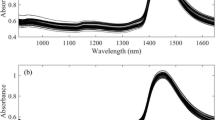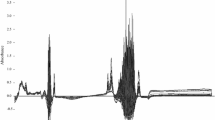Abstract
Currently, many newborns are consuming human milk (HM) donated by nursing mothers, especially those in the neonatal intensive care unit. However, a frequent problem in HM banks is the lack of information about the lactation phase of donated milk (colostrum, transition, or maturity), which makes it more difficult to supply children according to their particular needs. This research aims to develop models based on handheld near-infrared spectroscopy (NIR) coupled with partial least squares with discriminant analysis (PLS-DA) to individually classify HM in its different phases (colostrum—class 1; transition—class 2; mature—class 3). A total of 198 samples were pasteurized before spectra collection. Subsequently, several preprocessing techniques were investigated in NIR spectra using principal component analysis: multiplicative scatter correction (MSC), derivatives, and combinations between them. The NIR spectra preprocessed through MSC were employed in PLS-DA models, where sensitivity and specificity obtained were considered satisfactory for classifying mainly colostrum (87.5% and 90.3%, respectively) and mature (93.8% and 93.8%, respectively) phases. VIP scores showed that for the modeling of the colostrum phase the important regions are related to protein, while for the mature phase the lipids are more important. This plot also confirmed that the transition phase shares properties of the colostrum and mature phases, which probably contributed to its poor classification (rates ranging from 56.3 to 71.9%). Therefore, handheld NIR coupled with PLS-DA is suitable for the classification of HM in different phases of lactation in a low-cost and quick analysis. The proposal can be used in regulated banks to classify samples with unknown lactation phase before supplying them to newborns and can help to provide the ideal HM phase for their needs.





Similar content being viewed by others
References
Almeida MR, Fidelis CHV, Barata LES, Poppi RJ (2013) Classification of Amazonian rosewood essential oil by Raman spectroscopy and PLS-DA with reliability estimation. Talanta 117:305–311. https://doi.org/10.1016/j.talanta.2013.09.025
Almeida MMC, Francisco CRL, Oliveira A, Campos SS, Bilck AP, Fuchs RHB, Gonçalves OH, Valderrama P, Genema AK, Leimann FV (2018) Textural, color, hygroscopic, lipid oxidation, and sensory properties of cookies containing free and microencapsulated chia oil. Food Bioprocess Technol 11:926–939. https://doi.org/10.1007/s11947-018-2080-y
Alves FCGBS, Valderrama P (2015) Ultraviolet spectroscopy and supervised pattern recognition methods for authentication of transgenic and non-transgenic soybean oils. Anal Methods 7:9702–9706. https://doi.org/10.1039/C5AY02440D
Andreas NJ, Kampmann B, Mehring Le-Doare K (2015) Human breast milk: a review on its composition and bioactivity. Early Hum Dev 91:629–635. https://doi.org/10.1016/j.earlhumdev.2015.08.013
Bagchi TB, Sharma S, Chattopadhyay K (2016) Development of NIRS models to predict protein and amylose content of brown rice and proximate compositions of rice bran. Food Chem 191:21–27. https://doi.org/10.1016/j.foodchem.2015.05.038
Ballard O, Morrow AL (2013) Human milk composition nutrients and bioactive factors. Pediatr Clin N Am 60:49–74. https://doi.org/10.1016/j.pcl.2012.10.002
Baqueta MR, Coqueiro A, Março PH, Valderrama P (2020) Multivariate classification for the direct determination of cup profile in coffee blends via handheld near-infrared spectroscopy. Talanta 222:121526. https://doi.org/10.1016/j.talanta.2020.121526
Bertrand D, Robert P, Launay D, Devaux MF (1987) Application of principal component analysis to the determination of fat and protein content of milk by near-infrared spectroscopy. Proc Euro Food Chem. IV, Leon, Norwy, pp 519–523
Brazil (2008) Anvisa - Agência Nacional de Vigilância Sanitária. Banco de Leite Humano: Funcionamento, Prevenção e Controle de Riscos, 2008. http://www.redeblh.fiocruz.br/media/blhanv2008.pdf. Accessed 01 July 2020
Brazil (2009) Ministério da Saúde. SAÚDE DA CRIANÇA: Nutrição Infantil Aleitamento Materno e Alimentação Complementar. Série A. Normas e Manuais Técnicos Cadernos de Atenção Básica – n. 23, 2009. http://bvsms.saude.gov.br/bvs/publicacoes/saude_crianca_nutricao_aleitamento_alimentacao.pdf. Accessed 01 July 2020
Brazil (2019) Ministério da Saúde. Doação de leite: o que é, aleitamento materno, importância, como doar https://www.saude.gov.br/saude-de-a-z/doacao-de-leite-2019. Accessed 03 July 2020
Burns DA, Ciurczak EW (2007) Handbook of near-infrared analysis. CRC Press, Taylor & Francis Group, 3rd, pp 418-435
Castellote C, Casillas R, Ramirez-Santana C, Pérez-Cano FJ, Castell M, Moretones MG, López-Sabater MC, Franch A (2011) Premature delivery influences the immunological composition of colostrum and transitional and mature human milk. J Nutr 141:1181–1187. https://doi.org/10.3945/jn.110.133652
Chen YJ, Zhou XH, Han B, Li SM, Xu T, Yi HX, Liu P, Zhang LW, Li YY, Jiang SL, Pan JC, Ma CH, Wang BC (2020) Composition analysis of fatty acids and stereo-distribution of triglycerides in human milk from three regions of China. Food Res Int 133:109196. https://doi.org/10.1016/j.foodres.2020.109196
De Oliveira VMAT, Baqueta MR, Março PH, Valderrama P (2020) Authentication of organic sugars by NIR spectroscopy and partial least squares with discriminant analysis. Anal Methods 12:701–705. https://doi.org/10.1039/c9ay02025j
Eriksson L, Johansson E, Kettaneh-Wold N, Wold S (2001) Multi- and megavariate data analysis. Principles and applications. Umetrics Academy, Umea
Ferreira MMC (2015) Quimiometria: conceitos, métodos e aplicações, 1st edn, Editora da Unicamp, Campinas-SP
Fundação Oswaldo Cruz (Fiocruz) (2003) Programa Nacional de Qualidade em Bancos de Leite Humano. Rio de Janeiro
Fusch G, Rochow N, Choi A, Fusch S, Poeschl S, Ubah AO, Lee S-Y, Raja P, Fusch C (2015) Rapid measurement of macronutrients in breast milk: how reliable are infrared milk analyzers? Clin Nutr 34:465–476. https://doi.org/10.1016/j.clnu.2014.05.005
Gras-Le GC, Lepelletier D, Debillon T (2003) Contamination of a milk bank pasteurizer causing a Pseudomonas aeruginosa outbreak in a neonatal intensive care unit. Arch Dis Child Fetal Neonatal 88:434F–435F. https://doi.org/10.1136/fn.88.5.f434
Grelet C, Fernández Pierna JA, Dardenne P, Baeten V, Dehareng F (2015) Standardization of milk mid-infrared spectra from a European dairy network. J Dairy Sci 98:2150–2160. https://doi.org/10.3168/jds.2014-8764
Isaksson T, Naes T (1988) The effect of multiplicative scatter correction (MSC) and linearity improvement in NIR spectroscopy. Appl Spectrosc 42:1273–1284. https://doi.org/10.1366/0003702884429869
Kennard RW, Stone LA (1969) Computer-aided design of experiments. Technometrics 11:137–148. https://doi.org/10.1080/00401706.1969.10490666
Kotrri G, Fusch G, Kwan C, Choi D, Choi A, Al Kafi N, Rochow N, Fusch C (2016) Validation of correction algorithms for near-IR analysis of human milk in an independent sample set – effect of pasteurization. Nutrients 8:1–10. https://doi.org/10.3390/nu8030119
Kwan C, Fusch G, Bahonjic A, Rochow N, Fusch C (2017) Infrared analyzers for breast milk analysis: fat levels can influence the accuracy of protein measurements. Clin Chem Lab Med 55:1931–1935. https://doi.org/10.1515/cclm-2016-1042
López MI, Callao MP, Ruisánchez I (2015) A tutorial on the validation of qualitative methods: from the univariate to the multivariate approach. Anal Chim Acta 891:62–72. https://doi.org/10.1016/j.aca.2015.06.032
Mabood F, Jabeen F, Ahmed M, Hussain J, Al-Mashaykhi SAA, Al-Rubaiey ZMA, Farooq S, Boqué R, Ali L, Hussain Z, Al-Harrasi A, Khan AL, Naureen Z, Idrees M, Manzoor S (2017) Development of new NIR-spectroscopy method combined with multivariate analysis for detection of adulteration in camel milk with goat milk. Food Chem 221:746–750. https://doi.org/10.1016/j.foodchem.2016.11.109
Moreira I, Scarminio IS (2013) Chemometric discrimination of genetically modified Coffea Arabica cultivars using spectroscopic and chromatographic fingerprints. Talanta 107:416–422. https://doi.org/10.1016/j.talanta.2013.01.053
Ng DK, Lee SYR, Leung LCK, Wong SF, Ho JCS (2004) Bacteriological screening of expressed breast milk revealed a high rate of bacterial contamination in Chinese women. J Hosp Infect 58:146–150. https://doi.org/10.1016/j.jhin.2004.05.018
Nordey T, Joas J, Davrieux F, Chillet M, Léchaudel M (2017) Robust NIRS models for non-destructive prediction of mango internal quality. Sci Hortic 216:51–57. https://doi.org/10.1016/j.scienta.2016.12.023
Porep JU, Kammerer DR, Carle R (2015) On-line application of near-infrared (NIR) spectroscopy in food production. Trends Food Sci Technol 46:211–230. https://doi.org/10.1016/j.tifs.2015.10.002
Prell C, Koletzko B (2016) Breastfeeding and complementary feeding. Dtsch Arztebl Int 113:435–444. https://doi.org/10.3238/arztebl.2016.0435
Santana FB, Gontijo LC, Mitsutake H, Mazivila SJ, Souza LM, Borges Neto W (2016) Non-destructive fraud detection in rosehip oil by MIR spectroscopy and chemometrics. Food Chem 209:228–233. https://doi.org/10.1016/j.foodchem.2016.04.051
Sauer CW, Kim JH (2011) Human milk macronutrient analysis using point-of-care near-infrared spectrophotometry. J Perinatol 31:339–343. https://doi.org/10.1038/jp.2010.123
Savitzky A, Golay MJE (1964) Smoothing and differentiation of data by simplified least squares procedures. Anal Chem 36:1627–1639. https://doi.org/10.1021/ac60214a047
Taylor SN (2019) Solely human milk diets for preterm infants. Semin Perinatol 43:151–158. https://doi.org/10.1053/j.semperi.2019.06.006
Tu A, Ma Q, Bai H, Du Z (2017) A comparative study of triacylglycerol composition in Chinese human milk within different lactation stages and imported infant formula by SFC coupled with Q-TOF-MS. Food Chem 221:555–567. https://doi.org/10.1016/j.foodchem.2016.11.139
Valderrama L, Valderrama P (2016) Nondestructive identification of blue pen inks for documentoscopy purpose using iPhone and digital image analysis including an approach for interval confidence estimation in PLS-DA models validation. Chemom Intell Lab Syst 156:188–195. https://doi.org/10.1016/j.chemolab.2016.06.009
Veenstra C, Every DE, Petersen W, Goudoever JB, Steenbergen W, Bosschaart N (2020) Dependency of the optical scattering properties of human milk on casein content and common sample preparation method. J Biomed Opt 25:1–12. https://doi.org/10.1117/1.JBO.25.4.045001
Viegas TR, Mata AL, Duarte MML, Kássio MG, Lima KMG (2016) Determination of quality attributes in wax jambu fruit using NIRS and PLS. Food Chem 190:1–4. https://doi.org/10.1016/j.foodchem.2015.05.063
World Health Organization, March of Dimes, PMNCH, Save the Children (2012) Born too soon: The global action report on preterm birth. In: Howson CP, Kinney MV, Lawn JE (eds). New York
Wu D, Feng S, He Y (2008) Short-wave near-infrared spectroscopy analysis of major compounds in milk powder and wavelength assignment. Anal Chim Acta 610:232–242. https://doi.org/10.1016/j.aca.2008.01.056
Wu D, He Y, Shi JH, Feng SJ (2009) Exploring near and mid-infrared spectroscopy to predict trace iron and zinc contents in powdered milk. J Agric Food Chem 57:1697–1704. https://doi.org/10.1021/jf8030343
Acknowledgments
The authors thank Coordenação de Aperfeiçoamento de Pessoal de Nível Superior—Brazil (CAPES), Conselho Nacional de Desenvolvimento Científico e Tecnológico—Brazil (CNPq), and Fundação Araucária de Apoio ao Desenvolvimento Científico e Tecnológico do Estado do Paraná for the financial support and scholarship. P. Valderrama thanks Fundação Araucária (process 033/2019).
Author information
Authors and Affiliations
Corresponding authors
Ethics declarations
Conflict of Interest
Vanessa Jorge dos Santos declares that she has no conflict of interest. Michel Rocha Baqueta declares that he has no conflict of interest. Paulo Henrique Março declares that he has no conflict of interest. Patrícia Valderrama declares that she has no conflict of interest. Jesuí Vergílio Visentainer declares that he has no conflict of interest.
Ethical Approval
This study was approved by the Research Ethics Committee of UEM/Plataforma Brazil under protocol number 2,797,476.
Informed Consent
Not applicable.
Additional information
Publisher’s Note
Springer Nature remains neutral with regard to jurisdictional claims in published maps and institutional affiliations.
Supplementary Information
ESM 1
(DOCX 241 kb).
Rights and permissions
About this article
Cite this article
dos Santos, V.J., Baqueta, M.R., Março, P.H. et al. Human Milk Lactation Phases Evaluation Through Handheld Near-Infrared Spectroscopy and Multivariate Classification. Food Anal. Methods 14, 873–882 (2021). https://doi.org/10.1007/s12161-020-01924-y
Received:
Accepted:
Published:
Issue Date:
DOI: https://doi.org/10.1007/s12161-020-01924-y




